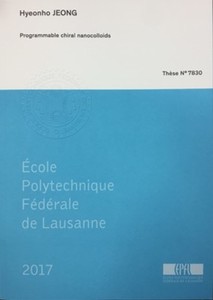Programmable chiral nanocolloids
2017
Ph.D. Thesis
pf
Nanoparticles promise a variety of application in energy, medicine, and biology. However, most nanoparticles’ material composition and shape cannot be tuned and so functions have thus far been limited. Moreover they are often also chemically unstable in solution. Therefore, the overall goal of this thesis is to develop nanoparticles whose function and shape can be programmed and that can be corrosion protected, and to then apply these nanoparticles to sensing tasks in complex biological fluids. A special focus of this thesis is chiral nanostructures. A promising technique to address this is physical vapour shadow growth, namely nano glancing angle deposition (nanoGLAD). This scheme allows the design of new three-dimensional (3D) hybrid nanoparticles as it permits the control over both the shape and material composition of the nanoparticles. Although this method offers the possibility to grow nanoparticles that are functionally programmed, it has so far not allowed the use of many materials that are chemically unstable in solution, which limits the scope of potential applications. This thesis starts with describing the nanoGLAD growth procedure. A first application is the wafer-scale patterning of unconventional nanoshapes, e.g. tri-layer particles, holes, rings, and hollow domes, which are not possible using state of the art 3D nanofabrication methods (chapter 2). Then, in conjunction with atomic layer deposition (ALD), this thesis shows how the nanoGLAD scheme can be adapted for the fabrication of ‘3D core-shell nanoparticles and nanocolloids’ using unstable and reactive materials. The key concept here is that the core consists of the unstable material which is grown such that the shell contains no voids or defects (chapter 3). Notably, the shapes that can be grown include symmetry-broken chiral nanoparticles, which possess unique spectral properties that make them useful for sensing applications. This thesis uses chiral nanocolloids to realise extremely sensitive plasmonic nanosensors and nanocolloids that can also be used as a nanomechanical probes for active nanorheology. By forming a composite of two materials during growth – one that gives a strong plasmonic response and the other to tune the composite’s dielectric function – plasmonic nanoparticles are presented that show record local surface plasmon resonance (LSPR) sensitivities to date (chapter 4). With the same alloying principle a plasmonic and a ferromagnetic material are combined. The resulting ‘chiral plasmonic ferromagnetic’ particles can be actuated using a magnetic field and this is used to measure the viscosity of blood plasma in the presence of blood cells. The viscosity of blood serum is an important disease indicator, but the measurement using commercial rheometers requires the separation of the blood cells. This is not needed in the nanorheological measurements shown in this thesis (chapter 5).
| Author(s): | Jeong, Hyeon-Ho |
| Year: | 2017 |
| Month: | July |
| Day: | 20 |
| Department(s): | Micro, Nano, and Molecular Systems |
| Bibtex Type: | Ph.D. Thesis (phdthesis) |
| School: | EPFL |
| DOI: | 10.5075/epfl-thesis-7830 |
|
BibTex @phdthesis{2017HHJPhD,
title = {Programmable chiral nanocolloids},
author = {Jeong, Hyeon-Ho},
school = {EPFL},
month = jul,
year = {2017},
doi = { 10.5075/epfl-thesis-7830},
month_numeric = {7}
}
|
|


